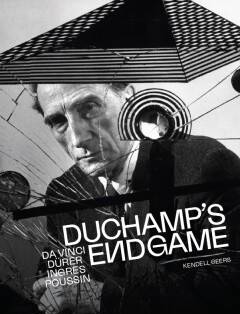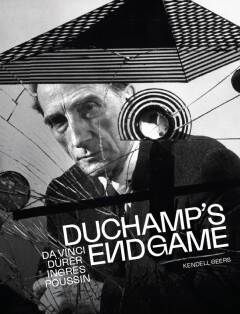
- Retrait gratuit dans votre magasin Club
- 7.000.000 titres dans notre catalogue
- Payer en toute sécurité
- Toujours un magasin près de chez vous
- Retrait gratuit dans votre magasin Club
- 7.000.0000 titres dans notre catalogue
- Payer en toute sécurité
- Toujours un magasin près de chez vous
45,00 €
+ 90 points
Description
In 1912 was Marcel Duchamp ontgoocheld in de Franse kunstscene. Daarom verliet hij Parijs en bracht hij drie maanden in München door. Hij beschrijft deze periode als de plaats van zijn 'complete bevrijding' en ze zette de toon voor de rest van zijn leven. Het was in München dat hij besloot om te stoppen met schilderen en in plaats daarvan readymades te maken. De hele loop van de 20ste-eeuwse kunstgeschiedenis veranderde als direct gevolg van deze 'complete bevrijding' en toch weten we niet wat er toen gebeurd is, behalve dat Duchamp twee kleine schilderijen en enkele tekeningen maakte. Honderd jaar later was de Zuid-Afrikaanse kunstenaar Kendell Geers in München om een retrospectieve tentoonstelling op te stellen in het Haus der Kunst, en hij kwam in een depressie terecht door zijn eigen ontgoocheling in de kunstscene. 'Duchamp's Endgame' is een persoonlijk boek over een kunstenaar die naar het werk van een andere kunstenaar kijkt en probeert om een honderd jaar oud enigma te doorgronden, te doorgronden wat het betekent o"Duchamp's Endgame" answers the century old question, what did Marcel Duchamp do in Munich in 1912 and why did he stop painting ? The book follows a visual logic driven by the question of how artists construct their imagery.
In 1912 Marcel Duchamp was disillusioned with the French art scene, so leaves Paris and spent 3 months in Munich. He describes this period as the scene of his "complete liberation" and it set the tone for the rest of his life. It was in Munich that he decided to stop painting and instead create readymade works of art. The entire course of twentieth century art history changes as a direct result of this "complete liberation" and yet we know absolutely nothing about what happened, except that Duchamp created 2 small paintings and a few drawings.
One hundred years later, South African artist Kendell Geers was in Munich to install a retrospective at the Haus der Kunst, and fell into a depression on account of his own disillusionment with the art scene. "Duchamp's Endgame" is a personal book about one artist looking at the work of another artist, trying to make sense of a century old enigma, trying to make sense of what it means to be an artist. Geers offers a unique reading of Duchamp that takes the reader on a labyrinthine journey through art history, revealing how one generation of artists secretly looked at another generation artists, all the way back to Leonardo da Vinci via Cranach, Poussin, Ingres and Durer. "Duchamp's Endgame" is a passionate story about art and the real life art historical version of the "Da Vinci Code" written by a contemporary artist with his tongue firmly in our cheek.
A century after Duchamp declared painting is dead, nobody has yet offered any evidence beyond conjecture what he meant by that statement. Kendell Geers uses the works of art themselves as visual evidence to explain what Duchamp was looking at and researching during his 3 month stay in Munich. The book follows the links between works of art created by 5 generations of artists, explored through the eyes of the artists themselves.
"Duchamp's Endgame" is entirely divergent from the official art historical canon on Marcel Duchamp in arguing that he was the last of a long line of classical European painters and not the American iconoclast of his reputation. The book focuses on the way artists think about other artists and argues that art historians have paid more attention to quoting each other, rather than taking the time to look at the actual works of art.
Kendell Geers has published in numerous art historical journals as well as contributed to books and conferences. In 2022 he presented a paper on African Art at a conference in Harvard University and in 2023 published an essay in Gavin Jantjes' retrospective catalogue for The Africa Institute and Sharjah Art Foundation. The book draws upon statements and quotes from Marcel Duchamp, but is entirely the author's own theory.
The publication accompanies a solo exhibition at Wilde Gallery in Basel presented during the Basel Art Fair.
In 1912 Marcel Duchamp was disillusioned with the French art scene, so leaves Paris and spent 3 months in Munich. He describes this period as the scene of his "complete liberation" and it set the tone for the rest of his life. It was in Munich that he decided to stop painting and instead create readymade works of art. The entire course of twentieth century art history changes as a direct result of this "complete liberation" and yet we know absolutely nothing about what happened, except that Duchamp created 2 small paintings and a few drawings.
One hundred years later, South African artist Kendell Geers was in Munich to install a retrospective at the Haus der Kunst, and fell into a depression on account of his own disillusionment with the art scene. "Duchamp's Endgame" is a personal book about one artist looking at the work of another artist, trying to make sense of a century old enigma, trying to make sense of what it means to be an artist. Geers offers a unique reading of Duchamp that takes the reader on a labyrinthine journey through art history, revealing how one generation of artists secretly looked at another generation artists, all the way back to Leonardo da Vinci via Cranach, Poussin, Ingres and Durer. "Duchamp's Endgame" is a passionate story about art and the real life art historical version of the "Da Vinci Code" written by a contemporary artist with his tongue firmly in our cheek.
A century after Duchamp declared painting is dead, nobody has yet offered any evidence beyond conjecture what he meant by that statement. Kendell Geers uses the works of art themselves as visual evidence to explain what Duchamp was looking at and researching during his 3 month stay in Munich. The book follows the links between works of art created by 5 generations of artists, explored through the eyes of the artists themselves.
"Duchamp's Endgame" is entirely divergent from the official art historical canon on Marcel Duchamp in arguing that he was the last of a long line of classical European painters and not the American iconoclast of his reputation. The book focuses on the way artists think about other artists and argues that art historians have paid more attention to quoting each other, rather than taking the time to look at the actual works of art.
Kendell Geers has published in numerous art historical journals as well as contributed to books and conferences. In 2022 he presented a paper on African Art at a conference in Harvard University and in 2023 published an essay in Gavin Jantjes' retrospective catalogue for The Africa Institute and Sharjah Art Foundation. The book draws upon statements and quotes from Marcel Duchamp, but is entirely the author's own theory.
The publication accompanies a solo exhibition at Wilde Gallery in Basel presented during the Basel Art Fair.
Spécifications
Parties prenantes
- Auteur(s) :
- Editeur:
Contenu
- Nombre de pages :
- 192
- Langue:
- Anglais
Caractéristiques
- EAN:
- 9789462303737
- Date de parution :
- 05-06-24
- Format:
- Livre relié
- Dimensions :
- 190 mm x 250 mm
- Poids :
- 800 g

Les avis
Nous publions uniquement les avis qui respectent les conditions requises. Consultez nos conditions pour les avis.






